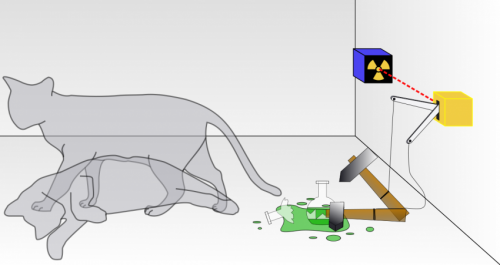September 24, 2015 report
Research pair offer a way to put a living organism into superposition state

(Phys.org)—A pair of physicists, one with Tsinghua University in China, the other with Perdue University in the U.S. has come up with what they believe is a viable way to cause a living organism to be in two places at the same time. In the paper they have posted to the arXiv server, Zhang-Qi Yin and Tongcang Li suggest that an experiment conducted at the University of Colorado recently, could be modified by placing a living organism into a superposition state, rather than using just a piece of metal.
The research pair liken their experimental idea to bringing to life to the famous Schrödinger thought experiment that involved a cat and other items placed in a closed box—or perhaps more poetically, comparing it to fairy tales where a fairy can exist in more than one place at the same time. Superposition, is of course, a principle of quantum theory that describes a concept where two objects can exist in more than one physical location at the same exact moment.
Two years ago, researchers at the University of Colorado put a very small vibrating aluminum membrane into a superposition state—Li and Yin believe that if a microbe were put on the same type of membrane it could be put into a superposition state along with the membrane. They note that to date, no one has put any sort of living organism into a superposition state, despite a lot of interest in doing so by both academics and the public at large.
More specifically, the team suggests the way to make it work would involve cooling a common bacterium down to approximately 10mK to prevent chemical activity from taking place and energy from being exchanged with the environment, then causing the microbe to adhere to the membrane using natural forces. That should be enough, they theorize, to allow for the bacterium to be put into a superposition state along with the oscillating membrane.
The scheme does raise the question of whether the organism is in fact living (but then so does Schrödinger's cat) because the microbe would be frozen solid—not dead, necessarily, because once warmed, it would wake and once again act like a living organism. The research pair note that they have no idea at this point how superposition might work with an active organism.
They also suggest that if anyone were to actually carry out their ideas via experiment, they might also consider doing another experiment, one that would use the same equipment and microbe, where the position of a microbe would be entangled with the spin of an atom residing inside of it—a way of testing for defective protein DNA inside of a living organism.
More information: Quantum superposition, entanglement, and state teleportation of a microorganism on an electromechanical oscillator, arXiv:1509.03763 [quant-ph] arxiv.org/abs/1509.03763
Abstract
Schrodinger's thought experiment to prepare a cat in a superposition of both alive and dead states reveals profound consequences of quantum mechanics and has attracted enormous interests. Here we propose a straightforward method to create quantum superposition states of a living microorganism by putting a small bacterium on top of an electromechanical oscillator. Our proposal is based on recent developments that the center-of-mass oscillation of a 15-μm-diameter aluminium membrane has been cooled to its quantum ground state [Nature 475, 359 (2011)], and entangled with a microwave field [Science, 342, 710 (2013)]. A microorganism with a mass much smaller than the mass of the electromechanical membrane will not significantly affect the quality factor of the membrane and can be cooled to the quantum ground state together with the membrane. Quantum superposition and teleportation of its center-of-mass motion state can be realized with the help of superconducting microwave circuits. More importantly, the internal states of a microorganism, such as the electron spin of a glycine radical, can be prepared in a quantum superposition state and entangled with its center-of-mass motion. Our proposal can be realized with state-of-art technologies. The proposed setup is also a quantum-limited magnetic resonance force microscope (MRFM) that not only can detect the existence of an electron spin, but also can coherently manipulate and detect the quantum state of the spin.
Journal information: arXiv
© 2015 Phys.org





















